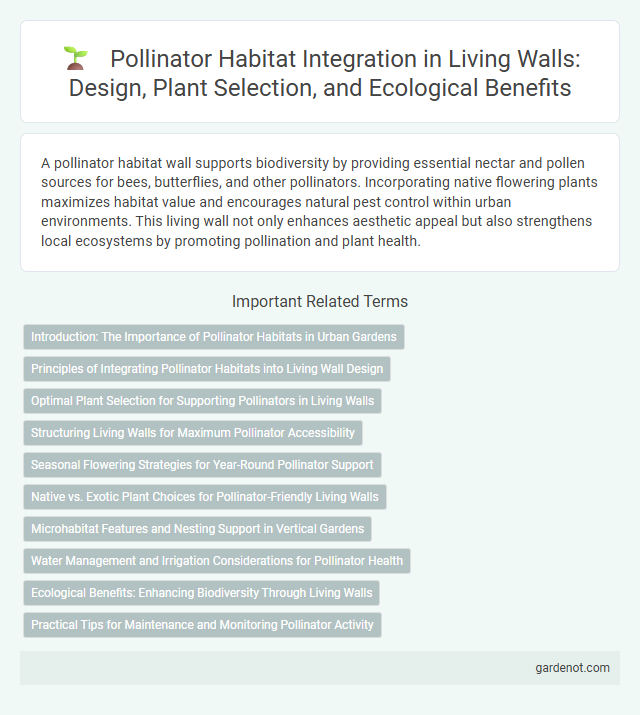A pollinator habitat wall supports biodiversity by providing essential nectar and pollen sources for bees, butterflies, and other pollinators. Incorporating native flowering plants maximizes habitat value and encourages natural pest control within urban environments. This living wall not only enhances aesthetic appeal but also strengthens local ecosystems by promoting pollination and plant health.
Introduction: The Importance of Pollinator Habitats in Urban Gardens
Pollinator habitat walls play a critical role in supporting biodiversity by providing essential resources such as nectar, pollen, and shelter in urban gardens. These living walls enhance plant pollination, which boosts urban food production and contributes to ecosystem health. Creating dedicated habitats for pollinators like bees, butterflies, and hummingbirds mitigates the decline of these species caused by habitat loss and pesticide use.
Principles of Integrating Pollinator Habitats into Living Wall Design
Integrating pollinator habitats into living wall design requires selecting native, nectar-rich plant species to support local pollinators such as bees, butterflies, and hummingbirds while ensuring vertical planting structures provide diverse microhabitats. Designing layers with varied bloom times maximizes floral availability throughout the seasons, enhancing pollinator foraging opportunities and biodiversity. Incorporating water sources, shelter elements, and minimal pesticide use further promotes a resilient and sustainable pollinator-friendly living wall ecosystem.
Optimal Plant Selection for Supporting Pollinators in Living Walls
Optimal plant selection for pollinator habitat walls involves choosing native flowering species that provide abundant nectar and pollen throughout the growing season. Incorporating a diverse range of bloom colors and shapes attracts various pollinators such as bees, butterflies, and hummingbirds, ensuring continuous support for their life cycles. Selecting drought-tolerant and low-maintenance plants enhances sustainability and resilience of living walls in urban environments.
Structuring Living Walls for Maximum Pollinator Accessibility
Designing pollinator habitat walls emphasizes selecting native flowering plants that bloom sequentially to provide continuous nectar sources. Structuring living walls with varied plant heights and open flower shapes ensures easy access for diverse pollinators like bees, butterflies, and hummingbirds. Incorporating nesting materials and avoiding pesticides further enhances the habitat's effectiveness for sustaining pollinator populations.
Seasonal Flowering Strategies for Year-Round Pollinator Support
Seasonal flowering strategies in pollinator habitat walls ensure continuous bloom cycles that attract diverse pollinators throughout the year. Incorporating native perennials, early spring bulbs, and late-blooming shrubs maximizes nectar and pollen availability across seasons. This diverse plant selection supports pollinators such as bees, butterflies, and hummingbirds by providing critical resources during periods of floral scarcity.
Native vs. Exotic Plant Choices for Pollinator-Friendly Living Walls
Pollinator habitat walls thrive using native plants, which provide essential nectar and pollen sources tailored to local pollinators' lifecycles and preferences. Exotic plants may offer visual diversity but often lack the necessary resources, sometimes disrupting local ecosystems or outcompeting native species. Prioritizing native flora enhances biodiversity, supports native pollinator populations like bees, butterflies, and hummingbirds, and contributes to sustainable living wall ecosystems.
Microhabitat Features and Nesting Support in Vertical Gardens
Pollinator habitat walls integrate diverse microhabitat features such as varied plant species, moisture-retentive substrates, and sheltered niches that promote pollinator activity and shelter. Vertical gardens designed with nesting support include cavities, hollow stems, and bee hotels that provide essential breeding sites for solitary bees and other pollinators. These features collectively enhance urban biodiversity by offering critical resources and safe habitats within compact, vertical green spaces.
Water Management and Irrigation Considerations for Pollinator Health
Effective water management is crucial for pollinator habitat walls to maintain optimal moisture levels that support diverse pollinator species without causing waterlogging or fungal growth. Drip irrigation systems with automated timers ensure consistent hydration while minimizing water waste and runoff, promoting sustainable resource use. Integrating moisture sensors allows real-time monitoring, optimizing irrigation schedules to enhance pollinator health and encourage native plant growth.
Ecological Benefits: Enhancing Biodiversity Through Living Walls
Pollinator habitat walls create vital ecosystems that support bees, butterflies, and other pollinators, enhancing urban biodiversity by providing food and shelter. These living walls contribute to ecological balance by promoting pollination, which is essential for the reproduction of flowering plants and agricultural crops. Integrating native plants into pollinator walls further enriches local flora and sustains diverse pollinator populations, improving overall environmental health.
Practical Tips for Maintenance and Monitoring Pollinator Activity
Maintaining a pollinator habitat wall requires regular inspection of plant health, removal of invasive species, and replenishment of native flowering plants to support continuous nectar and pollen availability. Monitoring pollinator activity can be enhanced using simple observational methods like timed counts or digital tools such as motion-activated cameras to track species diversity and visitation frequency. Consistent watering schedules and avoidance of pesticides ensure a thriving ecosystem that benefits both pollinators and the structural integrity of the living wall.
Pollinator habitat wall Infographic

 gardenot.com
gardenot.com